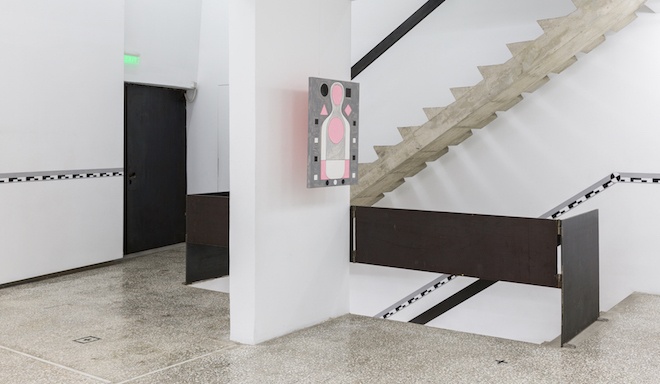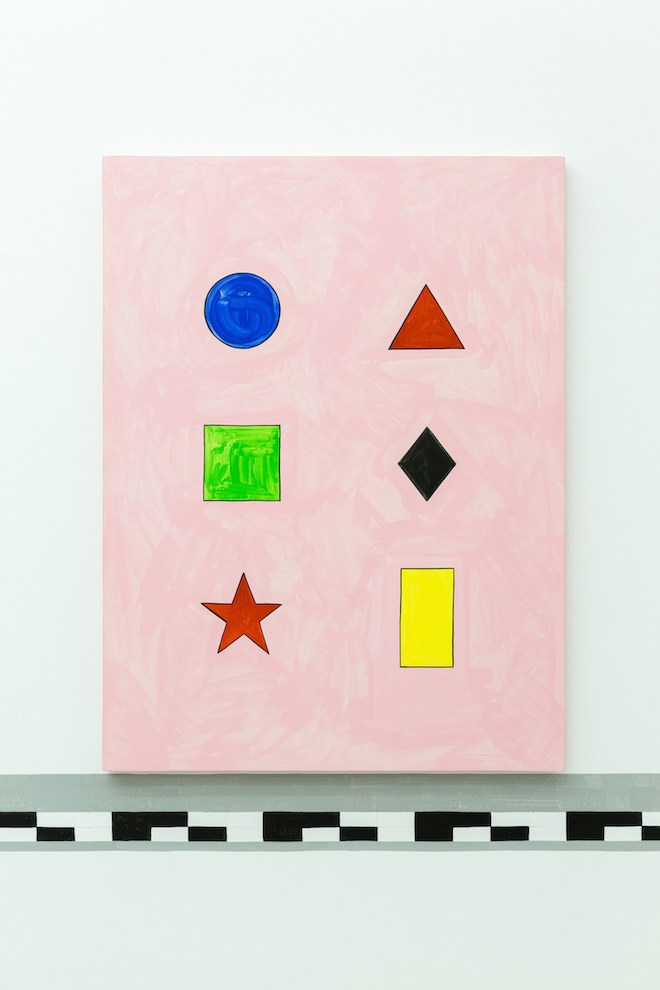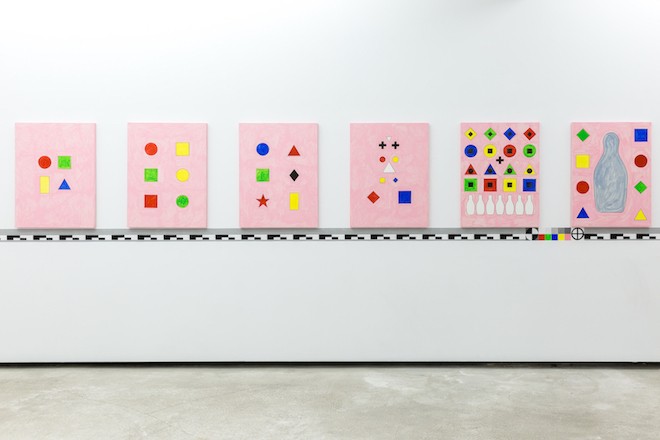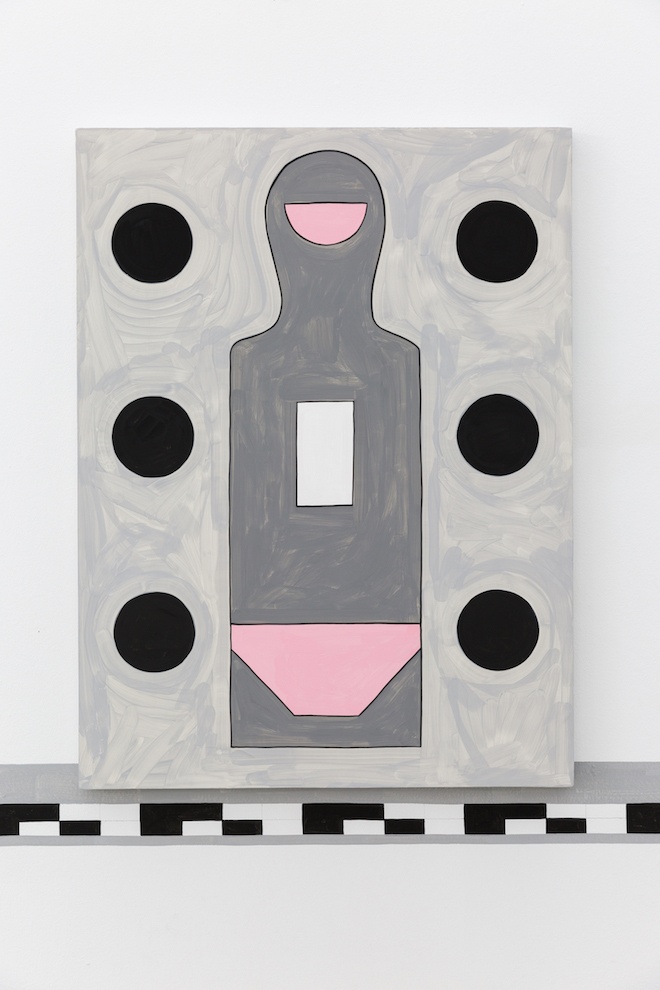Navine G. Khan-Dossos’ latest exhibition at The Breeder in Athens considers the theme of targets. Entitled Shoot The Women First, it draws on a command reported to be issued in the 1980s to members of West Germany’s elite GSG-9 anti-terrorist squad. The order forms the title of a book by Eileen McDonald, one of the many influences that worked to inform Dossos’ complex and multi-layered exhibition.
The opening of the exhibition on the first floor recreates a shooting range. The paintings begin with targets that use abstract shapes, and build until their depictions of humans are wholly recognisable. This movement to clarity is uneasy: at the moment you recognise the object, you also process a human will be shot. All the paintings are taken from actual targets. The tension is there again, with the paintings operating both as art and as a direct reflection of institutionalised killing. Curated as a shooting range, the audience is complicit in this complex relationship too – both a gallery visitor and a watchful bystander.
Downstairs in the gallery symbols on paintings refer to Discretionary Command training. Trainee shooters receive a chain of commands which require them to shoot at shapes and colours in a certain order. These objects represent an abstraction of human from human, and also of State from the individual. Especially of those considered to threaten existing structures.
Pink in Athens doesn’t have the millennial fashion connotations that it does in other European cities. Instead it evokes the colours of walls outside the brothels in the Metaxourgeio area, also the location of The Breeder gallery. The downstairs series was also informed by recent historical events around the area, specifically a case against a group of female drug-users in 2012, who were forced to take HIV tests. The women were publicly persecuted by the media and accused of grievous bodily harm for transmitting the virus through sex work. The use of the colour in her paintings then opens up new interpretations; pink is no longer beautiful, but violent. A shadow of war-mongering red. As is typical throughout the exhibition, Khan-Dossos offers a new way of seeing. The viewer is taken by surprise.

Navine G.Khan-Dossos, Grey Discretionary Command Series I-VIII, 2017 | Photos courtesy of The Breeder / © Alexandra Masmanidi
A graduate of Art at Cambridge University, Arabic at Kuwait University, Islamic Art at the Prince’s School of Traditional Art in London, and with an MA in Fine Art from Chelsea College of Art & Design, Navine G. Khan-Dossos brings a rigorous and intellectual approach to understanding the world around us. Her abstract paintings allow for an ontological study of shapes and symbols; historical references from both East and West, alongside contemporary digital contexts, examine and reflect on themes such as the depiction of European converts to radical Islam (‘Echo Chamber’, 2017), to the use of symbols and codes in the creation of crossrail at the House of St Barnabas in London (A Year Without Movement, 2017).
Her works are often site specific, and multi-dimensional. The opening of Shoot the Women First was accompanied with a performance by – enacting the shifting relationship between the collective and the other. Twin caught up with Navine to discuss the performance of identities and the idea of the other.
When did you first encounter Eileen McDonald’s text? What was the immediate impact it had on you?
Shoot The Women First by Eileen MacDonald was given to me for Christmas by my partner a couple of years ago. It raised a few eyebrows around the Christmas tree, that’s for sure. But my partner knows me pretty well, and given my long-term interest in female terrorists, it was a perfect gift for me. I read it immediately and have read it again many times since. But I also have shared it with those I’m working with on this project, in order for us all to begin the conversation from the same page.
The book is (as far as I know) the first attempt by a journalist to tackle the subject of female terrorists, and given when it was written in 1991, the interviews she conducts are with women whose memories and experiences of conflict and action are very recent and you can really feel that in the fabric of the book.
There are problems with it, such as an over-arching narrative that supposes that the violent political cause is somehow a child replacement for female terrorists; a cause into which they can put their maternal drive. This reduces women to a biological imperative of motherhood rather than seeing them as having genuine political will of their own, unconnected to their ovaries. This line of conclusion certainly dates the book, but I think as an archive of a specific time in history and the role of women within that turbulence, it’s a very valuable document and an inspiring one to begin something new to continue this dialogue in our own times.

Navine G.Khan-Dossos, Bulk Target 1-100, 2018 | courtesy of The Breeder / © Alexandra Masmanidi
In the accompanying essay to the exhibition Lisa Downing surmises that ‘ A “target,” then, by necessity, moves.’ What about this dynamic interested you?
Beyond this essay for the show, Lisa Downing thinks and writes more broadly about the role of the individual woman, the difficult woman, or the woman who finds herself unable to be part of a collective ‘we’ and I think this is the issue that underpins the target too. How does a woman stand apart but also identify with the group? The question of the target, for me, is tied up in this question of the individual and the multitude, being able to be alone but without being isolated or singled out for attack. And I think this is a pertinent question we must take forward with us into a future where we don’t have to be vulnerable or further this ‘otherness’ by individuating oneself.
Through the curation and the targets you open a discussion around complicity – where do you hope the viewer will place themselves in this dialogue?
I really don’t have any expectation of where the viewer should place themself within the work. It isn’t so didactic as to suggest one position. The intention is to keep things open, to reflect on the many roles that can be played out in the scenario of the shooting gallery: the target, the target designer, the shooter, the bystander, the amateur weekend gun enthusiast, the professional killer.

Navine G.Khan-Dossos, Shoot the Women First, Grey Discretionary Command Series I-VIII, 2017 |courtesy of The Breeder / © Alexandra Masmanidi
Why was it important to you to have a performance element of the exhibition? How did the collaboration come about?
This is the first time I have collaborated with a choreographer (Yasmina Reggad) and a group of dancers. Over a coffee in my studio when I was making he cardboard targets, Yamsina noticed how much the drying works resembled costumes, or certainly had the possibility of being worn. With her experience and her eyes, she saw not just the abstracted figure within the target, but how it could be embodied, given movement, and activated as part of the work’s scope beyond painting.
It was a very natural collaboration and Yasmina and I have been thinking and practicing together over the past weeks and months to think how we can work in parallel and share this common ground of interest.
The dancers will perform a mixture of martial arts-based movements choreographed within patterns used by riot police in crowd control situations. They will move those attending the opening of the show, pushing them out of the gallery, and controlling them through these delicate but powerful gestures.

Shoot the Women First performance, choreographed by Yasmina Reggad for Navine G. Khan-Dossos exhibition opening | photo courtesy of the artist / © Alexandra Masmanidi
I’m become quite fascinated by what a female army might look like in the future. The Kurdish female fighters of the YPJ (Kurdish Protection Units) continue to be a strong presence in my thoughts everyday, but I wonder also what ways of fighting and controlling crowds might be possible through other forms of intervention, which is why the inclusion of the martial arts is an interesting mode to explore. In a show that is dominated by the act of shooting and guns, this attempt to circumnavigate the use of this kind of instrument of violence is a way of imagining different possibilities for the future.
In the show text you reference specific examples of the 2012 arrests of suspected sex workers in Athens, as well as other major moments of terrorism throughout contemporary history. Can you talk a little about your research process, and why the story of the Greek women spoke to you in particular?
From the moment I found out about this story I was gripped by it, but also by the way it effected the Greek people I asked about it, and how they recalled that moment in time. I wasn’t yet living in Athens myself in 2012, so it was very much about exploring collective memory as well as more in-depth research. This case in some ways is very simple – an action made in the weeks leading up to a general election to make it look like the city was being cleaned up. But the complexity of the intermeshing subjects of HIV, of sex work, of the sanctity of family unit in Greece, also coalesce into something of great tragedy for the women at the heart of the events.
One of the first and most important influences on this research was the film Ruins by Zoe Mavroudi. She presented the story and the politics of what happened to these women in 2012 with a great dignity and power. Zoe and I discussed the making of the film and the issues surrounding it, but also the present situations of these women, and how not to lose sight of this case, but without re-presenting the women at the centre of the arrests, furthering the exploitation of their image.
Zoe introduced me to Apostolis Kalogiannis who was able to deepen my understanding of the current situation of sex work in Athens and how it has changed (or not) since 2012. This was an important way of grounding myself in the present rather than just looking back onto a concluded past event. There are important groups supporting vulnerable sex workers in Athens and there are ways for us to support their work through art, and by keeping the subject alive and visible.

Νavine G.Khan-Dossos, Pink Discretionary Command Series V-XII, 2017 | courtesy of The Breeder / © Alexandra Masmanidi
We spoke about the desire to focus on this story without re-enacting the violence that the women experienced in 2012. Could you elaborate on your approach to this?
The works are not and should never be considered a re-enactment of the situation in 2012. Those events are part of a much wider series of influences that went into making the works. But one important aspect that did derive directly from the issues raised by that case was how to represent women without returning to the low-grade viral images that swept through the Internet and the Greek media when the story broke.
I do not believe we need to re-present or indeed rely on these damaging images. Instead there must be a way to use a functional, diagrammatical, symbolic language that tells a wider story about the abstraction of the human body as a necessary device to distance oneself from the subject/target.
It is possible to make work about violence that in itself is not violent. It can be a contemplative or meditative space instead of a shocking one – a space where the viewer can consider the subject matter and recall what they already know inside themselves, including their own experiences, rather than forcing my narrative upon them.
I have been working on this approach to portraying difficult subject matter for a few years now, and it always changes depending on the subject matter. But I feel strongly that in this time of mass consumption of digital images of violence, there might be other ways to talk about it that don’t rely on the images themselves and getting caught up in that loop of the poor or degraded image (as Hito Steyerl might say).

Νavine G.Khan-Dossos, Pink Discretionary Command Series V-XII, 2017 | courtesy of The Breeder / © Alexandra Masmanidi
Do particular shapes and colours present themselves instinctively or do you always approach shapes and symbols to use in your work based on their pre-existing references and meanings?
All of my material comes from things that exist in the real world as functional objects or images. In this case all the paintings are based on Discretionary Command targets – a form of shooting practice target that relies on listening to commands and shooting the coloured shapes in the order given. So the shapes and colours have an inherent meaning within this context and a relationship to the human body in terms of organs (shoot to kill) and limbs (shoot to maim).
I have also included pink triangles as an additional shape to the pre-existing forms of the command targets, as a way of including the history and politics of the gay rights movement, which also has an important place in this work about the targeting of marginalised groups.
Shoot The Women First is on at The Breeder Gallery, Athens, until March 10th.


 PREVIOUS
PREVIOUS

 Twitter
Twitter
 Tumblr
Tumblr
 YouTube
YouTube
 Facebook
Facebook
 Instagram
Instagram
